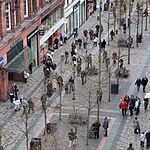Willow Tearooms

The Willow Tearooms are tearooms at 217 Sauchiehall Street, Glasgow, Scotland, designed by internationally renowned architect Charles Rennie Mackintosh, which opened for business in October 1903. They quickly gained enormous popularity, and are the most famous of the many Glasgow tearooms that opened in the late 19th and early 20th century. The building was fully restored, largely to Mackintosh's original designs, between 2014 and 2018. It was re-opened as working tea rooms in July 2018 and trades under the name "Mackintosh at The Willow". This follows a trademark dispute with the former operator of The Willow Tearooms which was resolved in 2017. This name is now used at tea room premises in Buchanan Street and was also additionally used at the Watt Brothers Department Store in Sauchiehall Street, Glasgow between 2016 and its closure in 2019.The Tea Rooms at 217 Sauchiehall Street first opened in 1903 and are the only surviving Tea Rooms designed by Charles Rennie Mackintosh for local entrepreneur and patron Miss Catherine Cranston. Over the years and through various changes of ownership and use, the building had deteriorated until it was purchased in 2014 by The Willow Tea Rooms Trust in order to prevent the forced sale of the building, closure of the Tea Rooms and loss of its contents to collectors.
Excerpt from the Wikipedia article Willow Tearooms (License: CC BY-SA 3.0, Authors, Images).Willow Tearooms
Sauchiehall Street, Glasgow Blythswood Hill
Geographical coordinates (GPS) Address Nearby Places Show on map
Geographical coordinates (GPS)
| Latitude | Longitude |
|---|---|
| N 55.865029166667 ° | E -4.2611608333333 ° |
Address
Sauchiehall Street
Sauchiehall Street
G2 3EQ Glasgow, Blythswood Hill
Scotland, United Kingdom
Open on Google Maps










